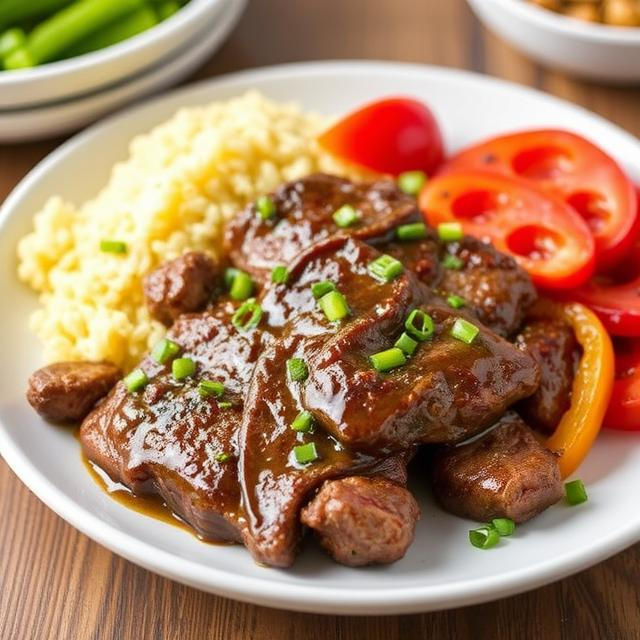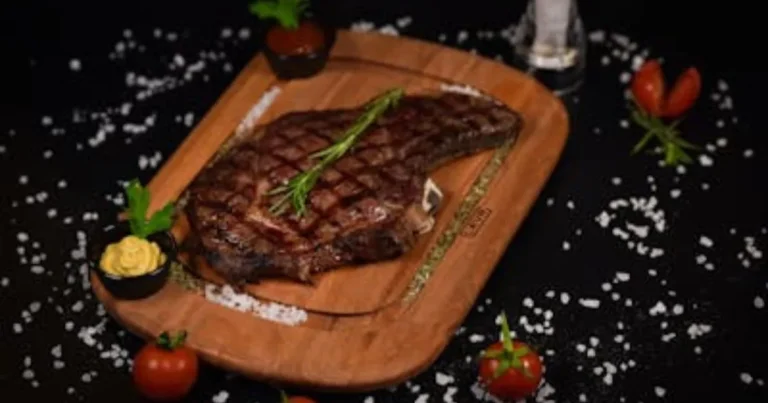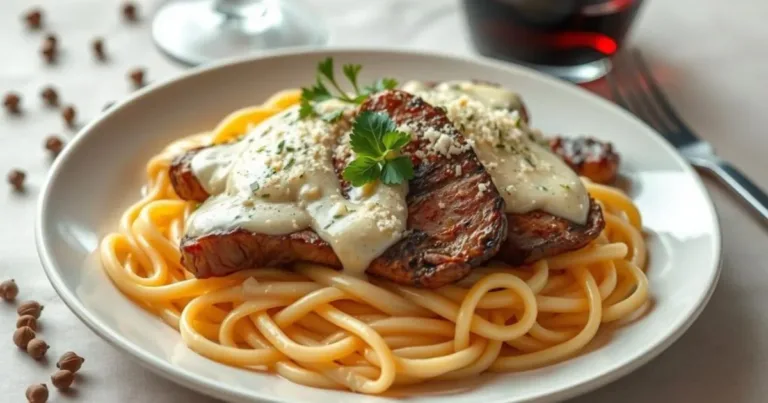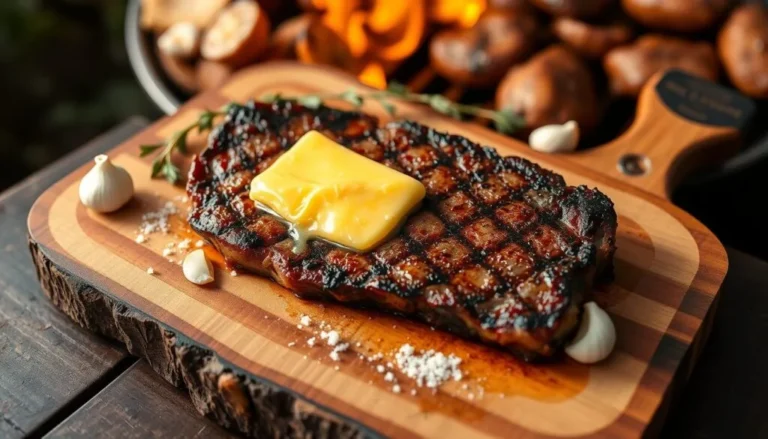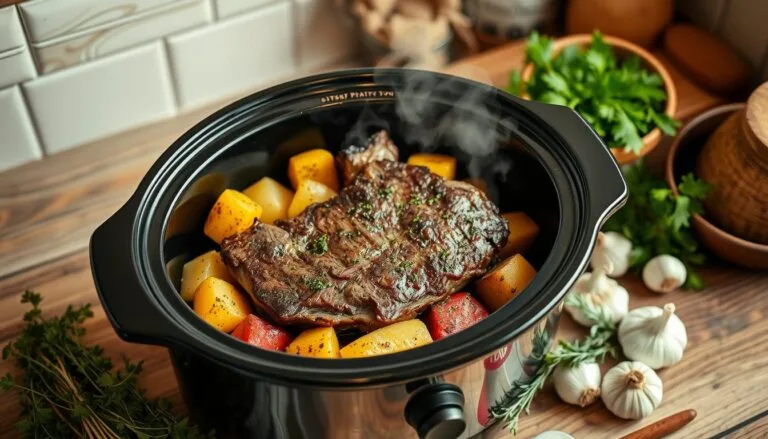Hibachi Steak Recipe How to Master the 4 Basics
Table of Contents
Have you ever wondered why hibachi steak recipe at Japanese restaurants tastes so much better than anything you cook at home? Is it really just fancy grills and dramatic chef performances, or is there a secret to that mouthwatering flavor and perfect texture that you can recreate in your own kitchen?
The truth might surprise you – mastering hibachi-style cooking isn’t about special equipment or chef tricks. It’s about understanding four basic techniques that transform ordinary steak into something extraordinary. And the best part? You can absolutely learn these techniques and make restaurant-quality hibachi steak right at home.
Overview: Why This Hibachi Steak Recipe Stands Out
This hibachi steak recipe isn’t just another steak dinner. It’s your ticket to bringing the Japanese steakhouse experience into your own kitchen. Here’s what makes it special:
Time Requirement: 30 minutes total (15 minutes prep, 15 minutes cooking)
Difficulty Level: Beginner-friendly
Equipment Needed: Large skillet or flat griddle (Blackstone hibachi recipe griddle works great, but isn’t required)
The four basics you’ll master in this steak hibachi recipe are:
- The perfect marinade
- The right cutting technique
- High-heat cooking method
- The signature sauce
Once you learn these fundamentals, you’ll be able to create hibachi-style meals that rival your favorite Japanese steakhouse – without the high prices or having to catch flying shrimp in your mouth!
Essential Ingredients for Authentic Hibachi Steak

For the Steak
- 1½ pounds ribeye or sirloin steak – Look for well-marbled cuts for the best flavor
- 2 tablespoons vegetable oil – For cooking at high heat
- 3 tablespoons soy sauce – Provides saltiness and umami
- 1 tablespoon sesame oil – Adds nutty flavor
- 2 tablespoons mirin (Japanese sweet cooking wine) – Brings sweetness and helps tenderize
- 1 tablespoon fresh ginger, grated – Adds zingy warmth
- 3 cloves garlic, minced – Essential for authentic flavor
- 1 tablespoon sugar – Helps with caramelization
For the Hibachi Sauce
- ¼ cup soy sauce – Base flavor
- 2 tablespoons butter – Creates richness
- 1 tablespoon fresh lemon juice – Adds brightness
- 2 tablespoons honey or brown sugar – For sweetness
- 1 teaspoon garlic powder – For flavor depth
- ½ teaspoon ground ginger – Adds warmth without texture
Substitutions and Variations
- Protein: Can’t find ribeye? Try New York strip, sirloin, or even chicken
- Mirin substitute: Use 2 tablespoons rice vinegar mixed with 1 teaspoon sugar
- Sesame oil alternative: Olive oil works but won’t have the same nutty flavor
- Soy sauce alternative: Coconut aminos for a gluten-free option
- Sweetener options: Brown sugar, maple syrup, or honey all work well
Step-by-Step Instructions for Perfect Hibachi Steak
Basic #1: The Perfect Marinade
- Prepare the steak: Place your steak in the freezer for 15 minutes. This facilitates thin slicing.
- Slice it right: Remove the steak and cut against the grain into thin strips about ¼-inch thick. Cutting against the grain breaks up the muscle fibers and makes the meat more tender.
- Mix the marinade: In a bowl, combine soy sauce, sesame oil, mirin, grated ginger, minced garlic, and sugar. Whisk until sugar dissolves.
- Marinate the meat: Place the sliced steak in a zip-top bag or shallow dish. Make sure all of the meat is covered by pouring the marinade over it. Seal and refrigerate for at least 15 minutes, but no longer than 1 hour (the acid in the marinade can make the meat mushy if left too long).
Pro Tip: Don’t have time to marinate? You can still get great flavor by tossing the sliced meat in the marinade just before cooking, but let it sit at room temperature for at least 5 minutes to take the chill off.
Basic #2: The Right Cutting Technique
- Prepare your workspace: Have a sharp knife and clean cutting board ready.
- Identify the grain: Look at your steak and find the direction of the muscle fibers (the grain).
- Position your knife: Place your knife perpendicular to these lines, not parallel.
- Slice with confidence: Using a sharp knife, cut across the grain in one smooth motion rather than sawing back and forth.
- Create bite-sized pieces: Aim for pieces that are about 1-inch wide and ¼-inch thick.
Pro Tip: Dull knives are dangerous knives! Make sure your knife is sharp. A sharp knife requires less pressure and gives you more control, reducing the risk of accidents.
Basic #3: High-Heat Cooking Method
- Preheat your cooking surface: Heat a large skillet, flat-top griddle, or Blackstone hibachi recipe griddle over high heat until it’s very hot. Immediately after sizzling, a drop of water should disappear.
- Add oil: Once hot, add 1 tablespoon of vegetable oil and swirl to coat the surface.
- Arrange the meat: Using tongs, place the marinated steak strips on the hot surface in a single layer. Don’t overcrowd the pan – cook in batches if needed.
- Cook with patience: Let the meat sear without moving it for 1-2 minutes to develop a nice crust.
- Flip and finish: Turn the meat once and cook for another 1-2 minutes for medium-rare to medium. The thin strips cook quickly!
- Remove and rest: Transfer the cooked steak to a clean plate and let it rest for 2-3 minutes.
Pro Tip: The key to that hibachi restaurant flavor is cooking at high heat. Don’t be afraid of the heat – embrace it! But keep a close eye on your steak as it cooks quickly at these temperatures.
Basic #4: The Signature Sauce
- Prepare your sauce ingredients: Measure all ingredients before you start cooking.
- Make the sauce: In a small saucepan, combine soy sauce, butter, lemon juice, honey or brown sugar, garlic powder, and ground ginger.
- Heat gently: Warm over medium-low heat, stirring until the butter melts and the sauce is smooth.
- Simmer briefly: Let it simmer for 1-2 minutes to meld the flavors, but don’t let it reduce too much.
- Taste and adjust: Sample your sauce and adjust seasoning if needed.
Pro Tip: Make extra sauce! This hibachi sauce is amazing on vegetables, rice, and even as a marinade for other proteins.
Assembly: Bringing Your Hibachi Steak Meal Together
- Prepare your plate: Warm your serving plates if possible.
- Layer your foundation: Start with a bed of steamed rice, fried rice, or noodles.
- Add the star: Arrange your perfectly cooked hibachi steak on top.
- Pour on the flavor: Drizzle the signature sauce over the steak and rice.
- Add the sides: Complete your hibachi experience with:
- Grilled vegetables (zucchini, onions, mushrooms)
- Bean sprouts
- A sprinkle of sesame seeds
- Sliced green onions for garnish
Presentation Tips:
- Temperature matters: Serve immediately while hot
- Color contrast: Add a sprinkle of black and white sesame seeds for visual appeal
- Sauce control: Serve extra sauce on the side for dipping
- Fun factor: Include chopsticks for an authentic experience
Pro Tip: For a true hibachi experience, serve with a side of ginger dipping sauce and “yum yum sauce” (Japanese steakhouse white sauce).
Storage and Make-Ahead Tips
Storing Leftovers:
- Cool completely: Let the steak cool before refrigerating
- Proper containers: Store in airtight containers
- Refrigeration time: Keeps for 3-4 days in the refrigerator
- Freezing option: Can be frozen for up to 2 months
Reheating:
- Gentle warming: Reheat in a skillet over medium heat with a splash of water to prevent drying out
- Microwave method: Cover with a damp paper towel and heat in 30-second intervals
- Sauce revival: If the sauce has thickened, thin with a little water or broth
Make-Ahead Options:
- Prep the marinade: Can be made up to 3 days in advance
- Slice the meat: Prep up to 24 hours ahead and store separately from marinade
- Pre-make the sauce: Can be prepared 5 days ahead and refrigerated
- Chop vegetables: Prep up to 2 days in advance for quick assembly
Pro Tip: For meal prep, cook the steak just shy of your preferred doneness. When reheating, it will reach the perfect temperature without overcooking.
Recipe Variations to Keep Things Exciting
Protein Alternatives:
- Chicken Hibachi: Substitute boneless chicken thighs or breasts
- Shrimp Hibachi: Use large peeled and deveined shrimp (reduce cooking time)
- Tofu Hibachi: Press extra-firm tofu, slice, and follow the same instructions
- Mixed Hibachi: Combine steak with chicken or shrimp for a surf and turf experience
Flavor Twists:
- Spicy Hibachi: Add sriracha or red pepper flakes to the marinade
- Teriyaki Style: Increase the sugar content in the sauce and add pineapple juice
- Garlic Lover’s: Double the garlic in both marinade and sauce
- Citrus Infused: Add orange zest to the marinade for brightness
Dietary Adaptations:
- Low-Carb Option: Serve over cauliflower rice
- To make it gluten-free: substitute coconut aminos or tamari for soy sauce.
- Lower Sodium: Use reduced-sodium soy sauce and unsalted butter
- Paleo-Friendly: Use coconut aminos and honey or maple syrup for sweetness
Pro Tip: Create a hibachi “bar” for family dinners where everyone can customize their plates with different proteins, vegetables, and sauce options.
Conclusion: Your Hibachi Adventure Begins!
Congratulations! You’ve now mastered the four basics of making restaurant-quality hibachi steak at home: the perfect marinade, proper cutting technique, high-heat cooking method, and signature sauce. With these fundamentals under your belt, you can bring the excitement and flavors of a Japanese steakhouse to your own kitchen any night of the week.
Don’t be afraid to experiment and make this hibachi steak recipe your own. Try different cuts of meat, play with the marinade ingredients, or create new sauce variations. Cooking’s inventiveness and individuality are what make it so beautiful.
Remember, the most important ingredient is confidence. Your hibachi steak might not be identical to your favorite restaurant’s version the first time, but with practice, you’ll develop your own signature style that your family and friends will request again and again.
So fire up that griddle, sharpen your knife, and get ready to impress everyone (including yourself) with your newfound hibachi skills. Your taste buds – and your wallet – will thank you!
FAQs About Hibachi Steak
What’s the difference between hibachi and teppanyaki cooking?
Hibachi traditionally refers to a charcoal-heated barbecue grill with an open grate design. Teppanyaki uses a flat iron griddle to cook food. In America, the terms are often used interchangeably for the style of cooking performed at Japanese steakhouses.
Can I make hibachi steak without a special grill?
Absolutely! While a flat top griddle like a Blackstone hibachi recipe griddle is ideal, a large cast iron skillet or regular flat pan works great too. The key is high heat and quick cooking.
What cut of beef is best for hibachi steak?
Ribeye and sirloin are excellent choices due to their flavor and tenderness. New York strip also works well. Look for good marbling for the best flavor.
How do I make vegetarian hibachi?
Substitute the steak with firm tofu, portobello mushrooms, or seitan. Marinate and cook using the same method as the steak recipe.
Is hibachi steak healthy?
Hibachi steak can be part of a healthy diet. It’s high in protein and you control the ingredients. For a healthier version, use less oil, reduce sodium by using low-sodium soy sauce, and serve with plenty of vegetables.
Can I cook the vegetables at the same time as the steak?
It’s best to cook vegetables separately since they require different cooking times. Cook harder vegetables like carrots first, then softer ones like zucchini, and finally quick-cooking items like bean sprouts.
What’s the white sauce served at hibachi restaurants?
That’s often called “yum yum sauce” or Japanese white sauce. It’s made with mayonnaise, rice vinegar, a little sugar, paprika, garlic powder, and sometimes a touch of tomato paste.
How can I get that smoky flavor without a flame grill?
Try adding a drop of liquid smoke to your marinade, or use a small amount of smoked paprika. You can also finish the dish with a sprinkle of smoked salt.
My sauce is too thin/thick. How do I fix it?
If too thin, simmer a bit longer to reduce. If too thick, add a splash of water, broth, or even pineapple juice for a flavor twist.
What side dishes go best with hibachi steak?
Traditional sides include steamed rice, hibachi fried rice, hibachi noodles, miso soup, and a simple green salad with ginger dressing.
Share Your Experience With us
There are no reviews yet. Be the first one to write one.

